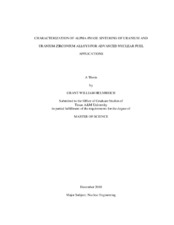| dc.description.abstract | The sintering behavior of uranium and uranium-zirconium alloys in the alpha phase were
characterized in this research. Metal uranium powder was produced from pieces of depleted
uranium metal acquired from the Y-12 plant via hydriding/dehydriding process. The size
distribution and morphology of the uranium powder produced by this method were determined
by digital optical microscopy.
Once the characteristics of the source uranium powder were known, uranium and
uranium-zirconium pellets were pressed using a dual-action punch and die. The majority of
these pellets were sintered isothermally, first in the alpha phase near 650°C, then in the gamma
phase near 800°C. In addition, a few pellets were sintered using more exotic temperature
profiles. Pellet shrinkage was continuously measured in situ during sintering.
The isothermal shrinkage rates and sintering temperatures for each pellet were fit to a
simple model for the initial phase of sintering of spherical powders. The material specific
constants required by this model, including the activation energy of the process, were determined
for both uranium and uranium-zirconium.
Following sintering, pellets were sectioned, mounted, and polished for imaging by
electron microscopy. Based on these results, the porosity and microstructure of the sintered pellets were analyzed. The porosity of the uranium-zirconium pellets was consistently lower
than that of the pure uranium pellets. In addition, some formation of an alloyed phase of
uranium and zirconium was observed.
The research presented within this thesis is a continuation of a previous project; however,
this research has produced many new results not previously seen. In addition, a number of issues
left unresolved by the previous project have been addressed and solved. Most notably, the low
original output of the hydride/dehydride powder production system has been increased by an
order of magnitude, the actual characteristics of the powder have been measured and determined,
shrinkage data was successfully converted into a sintering model, an alloyed phase of uranium
and zirconium was produced, and pellet cracking due to delamination has been eliminated. | en |


